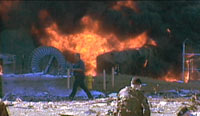|
A timeline tracking the evolution of the Bush administration's bold legal framework and aggressive interrogation policies for prosecuting the war on terror -- and how it links to the prisoner abuse at Abu Ghraib and beyond. [Note: Many of the related documents in this timeline are pdf files; Adobe Acrobat required]
Oct. 17, 2001 CENTCOM issues order applying Geneva Conventions to detainees in Afghanistan
The military is directed to take the standard approach and determine whether enemies captured on the battlefield would receive prisoner of war status. If so, the Geneva Conventions would apply. Nov. 13, 2001 Bush authorizes military tribunals
The president's executive order states: Given the danger to the safety of the United States and the nature of international terrorism … I find consistent with section 836 of title 10, United States Code, that it is not practicable to apply in military commissions under this order the principles of law and the rules of evidence generally recognized in the trial of criminal cases in the United States district courts. The order allows the military to detain non-U.S. citizens whom the president determined "has engaged in, aided or abetted, or conspired to commit acts of international terrorism" or those who have "knowingly harbored" terrorists. It gives custody of those suspects to the Secretary of Defense and orders that those individuals be "treated humanely," "afforded adequate food, drinking water, shelter, clothing, and medical treatment," and "allowed the free exercise of religion." It promises "a full and fair trial," and admits evidence that would, in the opinion of the military commission's presiding officer, "have probative value to a reasonable person." According to The New York Times, the case for the tribunals is laid out in a 35-page memo dated Nov. 9 from Deputy Assistant Attorney General Patrick F. Philbin to White House Counsel Alberto Gonzales. The memo, which has not been released, but was reviewed by the Times, says that the president has "inherent authority" as commander in chief to establish military commissions. It cites Ex Parte Quirin, a 1942 case in which the Supreme Court upheld a decision by President Franklin Roosevelt to try eight Nazi saboteurs by a military commission. "None of us knew for certain whether military commissions would or would not be needed, would or would not be a wise way to try the war criminals of Al Qaeda that we were catching," former White House Associate Counsel Bradford Berenson tells FRONTLINE. "But we wanted to make sure that that tool was available if and when the president and the secretary of defense decided that it was needed." Dec. 27, 2001 High-value detainees will go to Guantanamo
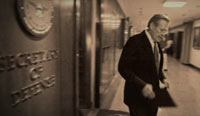
Secretary of Defense Donald Rumsfeld At a press conference, Secretary Rumsfeld describes the U.S. Naval base at Guantanamo, commonly referred to as "Gitmo," as "the least worst" place to hold detainees. "Guantanamo has a number of important advantages as a place for the long-term capture and detention of terrorists," explains Berenson. "First and foremost, it's completely secure. … I think the proximity to the United States was also perceived as an advantage… And I think also at the time, we thought the fact that Guantanamo was outside the territory of the United States would eliminate an important legal ambiguity." In a Dec. 28 memo to Defense Department General Counsel William J. Haynes, John Yoo and Deputy Assistant Attorney General Patrick Philbin argue that federal courts do not have jurisdiction to entertain habeas corpus petitions from individuals held at Guantanamo. The opinion is based on Johnson v. Eisentrager, a 1950 decision in which the Supreme Court ruled that the federal court system did not have jurisdiction to hear cases filed by enemy aliens who had been seized and held outside U.S. territory. However, the authors warn: If a federal district court were to take jurisdiction over a habeas petition, it could review the constitutionality of the detention and the use of a military commission, the application of certain treaty provisions, and perhaps even the legal status of al Qaeda and Taliban members. In June 2004, the Supreme Court rules in Rasul v. Bush that detainees have the right to challenge their detention in federal court. Since the court's ruling, more than 100 habeas corpus petitions have been filed on behalf of 225 detainees. January-February 2002 Bush administration's internal battle over Geneva Conventions
On Jan. 9, John Yoo and Special Counsel Robert Delahunty send a memo to William J. Haynes arguing that the Geneva Conventions governing the treatment of prisoners of war do not apply to Al Qaeda or the Taliban. They reason that as a non-state actor, Al Qaeda is not a party to international treaties of war, and that the Taliban is not covered because 1) Afghanistan is a "failed state" with no functioning government, and 2) the Taliban "may have been so intertwined with al Qaeda as to be functionally indistinguishable from it." The memo also reasons that the president is not bound by customary international law because it is not recognized in the Constitution. It draws back on the broad war authorization passed by Congress on Sept. 14, 2001, saying that gives the president "sweeping authority with respect to the present conflict." William Howard Taft, IV, Secretary Powell's legal adviser, responds to Yoo's memo with a Jan. 11 memo of his own in which he calls Yoo's analysis "seriously flawed" and his conclusion "untenable." He writes: "In previous conflicts, the United States has dealt with tens of thousands of detainees without repudiating its obligations under the Conventions. I have no doubt we can do so here, where only a relative handful of persons is involved." On Jan. 18, the president decides the Geneva Conventions will not apply to either Al Qaeda or the Taliban. And on Jan. 19, Secretary Rumsfeld makes it official, sending a memo to Chairman of the Joint Chiefs of Staff Richard Myers that exempts Al Qaeda and Taliban prisoners from the Geneva Conventions. But the dispute does not end. In response to concerns from Secretary of State Colin Powell, White House Counsel Alberto Gonzales sends a memo describing the war on terror as "a new paradigm" and reiterating the previous arguments as to why the two organizations are not covered. He lays out the positive and negative consequences of a determination that Geneva would not apply and argues that one positive consequence would be preserving flexibility: As you have said, the war against terrorism is a new kind of war. It is not the traditional clash between nations adhering to the laws of war that formed the backdrop for [Geneva Convention III on the Treatment of Prisoners of War]. The nature of the new war places a high premium on other factors, such as the ability to quickly obtain information from captured terrorists and their sponsors in order to avoid further atrocities against American civilians, and the need to try terrorists for war crimes such as wantonly killing civilians. In my judgment, this new paradigm renders obsolete Geneva's strict limitations on questioning of enemy prisoners and renders quaint some of its provisions requiring that captured enemy be afforded such things as commissary privileges, scrip (i.e., advances of monthly pay), athletic uniforms, and scientific instruments. Gonzales concludes that the benefits of not applying Geneva outweigh the concerns. The following day Secretary Powell responds to Gonzales's memo. "I am concerned that the draft [of Gonzales' Jan. 25 memo] does not squarely present to the President the options that are available to him," he writes. He argues that the president should apply Geneva to the conflict in Afghanistan, but reserve the option to exempt Al Qaeda or Taliban individuals from prisoner of war status. Such an approach, he writes, not only protects U.S. forces, but "presents a positive international posture, preserves U.S. credibility and moral authority by taking the high ground, and puts us in a better position to demand and receive international support." The president makes his final decision on Feb. 7: Taliban and Al Qaeda detainees will not be entitled to Geneva protections. The president writes in his memo, entitled "Human Treatment of al Qaeda and Taliban Detainees": Of course, our values as a Nation … call for us to treat detainees humanely, including those who are not legally entitled to such treatment. Our Nation has been and will continue to be a strong supporter of Geneva and its principles. As a matter of policy, the United States Armed Forces shall continue to treat detainees humanely and, to the extent appropriate and consistent with military necessity, in a manner consistent with the principles of Geneva. Critics, including some of the military's uniformed lawyers, have argued that the latter part of the president's statement provides a loophole allowing the administration to sidestep its pledge to treat detainees humanely. Jan. 11, 2002 First detainees arrive at Guantanamo
At a press conference, Secretary Rumsfeld explains, "They will be handled not as prisoners of war, because they're not, but as unlawful combatants. As I understand it, technically unlawful combatants do not have any rights under the Geneva Convention. We have indicated that we do plan to, for the most part, treat them in a manner that is reasonably consistent with the Geneva Conventions, to the extent they are appropriate, and that is exactly what we have been doing." 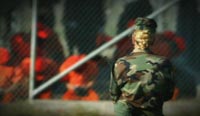
A guard standing near imprisoned detainees Administration officials will continuously describe the detainees at Guantanamo as "the worst of the worst." At the same press conference, Chairman of the Joint Chiefs Richard Myers says, "We've got to remember that these are very dangerous people. These are people that would gnaw through hydraulic lines to bring it down. These are very dangerous people and that's how they're being treated." He continues to explain that the detainees will receive humane treatment: "At the same time, let me give you context on how they're going to be handled when they hit the Guantanamo Bay. The meals will be served, culturally appropriate for them, and so, I mean, we're going to try to do our best to treat them humanely, at the same time realizing they're very dangerous people." Summer 2002 Frustration at lack of useful intelligence coming out of Gitmo
Six months after detainees first arrived at Guantanamo, interrogators are learning bits and pieces of information, but the Defense Department isn't satisfied. "The feedback that I was getting was that the information initially wasn't as valuable as it could be and we just had to get better organized for that," Gen. Jack Keane, vice chief of staff for the U.S. Army told FRONTLINE. Rumsfeld sends Gen. Keane to visit the base. "I was not happy with it…" Keane says. "We had two functions there… One is intelligence operations, and the other one is a custodial function in the sense of police function. And they were not cooperating with each other, and we had two commanders down there who were not working together." Gen. Keane recommends that the military intelligence and military police functions be brought together under a unified command. Aug. 1, 2002 The so-called "torture memo"
Assistant Attorney General Jay S. Bybee sends White House Counsel Gonzales a memo which parses the language of a 1994 U.S. statute that ratified the United Nations Convention against Torture, and made the commitment of torture a crime. The memo concludes that only acts that intentionally result in physical pain "equivalent in intensity to the pain accompanying serious physical injury, such as organ failure, impairment of bodily function, or even death" are tantamount to torture. The memo, which also argues that the president could authorize torture under his constitutional powers as commander in chief, is issued in response to a request for guidance by the CIA, which held high-value Al Qaeda prisoners, including Abu Zubaida, Al Qaeda's operations chief, who was captured in Pakistan in March 2002. The memo causes a furor when it is published by The Washington Post in June 2004, and it is disavowed by the Justice Department on Dec. 30, 2004, just days before Gonzales appears before the Senate Judiciary Committee for hearings on his nomination as attorney general. Read more about the torture memo. Oct. 11, 2002 Request to approve harsher interrogation techniques at Gitmo
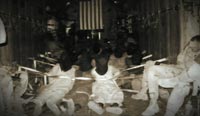
Hooded prisoners being transported Gen. Michael Dunlavey, who heads the Military Intelligence (MI) task force at Guantanamo writes his superiors at U.S. Southern Command (SOUTHCOM), requesting approval for certain counter-resistance strategies. The strategies are divided into three levels: Category I techniques include yelling at or deceiving the detainee. Category II techniques include the use of stress positions, such as standing, for up to four hours; use of the isolation facility for up to 30 days; hooding during transportation and questioning; conducting 20-hour interrogations; removal of "comfort items (including religious items)"; removing clothing; forced grooming; and "using detainees individual phobias (such as fear of dogs) to induce stress." Category III techniques are requested to be used only by commanding general approval on the most uncooperative detainees (said to be less than 3 percent of the population). The techniques include:
Gen. James Hill, the commander of SOUTHCOM, forwards Gen. Dunlavey's request to the Defense Department on Oct. 25. "I desire to have as many options as possible at my disposal," he writes, "and therefore request that Department of Defense and Department of Justice lawyers review the third category of techniques. … I believe we should provide our interrogators with as many legally permissible tools as possible." Nov. 4, 2002 Gen. Geoffrey Miller takes command at Gitmo
Gen. Miller arrives to take charge of the 625 inmates at Guantanamo. He institutes a rewards system for cooperative detainees and brings in behavioral scientists to examine the detainees for psychological vulnerabilities. He also blurs the traditional line between MPs, whose role is to guard prisoners and take care of their well being, and the MI, whose role is to obtain information. "There was no separation between the two," says Sgt. Maj. John Van Natta, who supervised the prison at Gitmo from 2002 to 2003. According to Gen. Paul Kern, after Gen. Miller's arrival, "People, if they went down there, they saw conditions had changed. People were living in reasonable conditions and they started getting intelligence reports out of there which were leading to actionable intelligence, something we could do something about." Dec. 2, 2002 Rumsfeld OKs interrogation techniques
Rumsfeld approves the use of Category I and II techniques from Gen. Dunlavey's Oct. 11 memo. He also approves the use of the mild, non-injurious physical contact from the Category III techniques. However, Rumsfeld, who uses a standing desk, writes on the memo, "I stand for 8-10 hours a day. Why is standing limited to four hours?" The Independent Panel to Review DoD Detainee Operations (known as the "Schlesinger report") would conclude in August 2004, "It is clear that the pressure for additional intelligence and the more aggressive methods sanctioned by the Secretary of Defense memorandum resulted in stronger interrogation techniques. They did contribute to a belief that stronger interrogation methods were needed and appropriate in the treatment of detainees." Jan. 15, 2003 Rumsfeld rescinds earlier memo
Rumsfeld disallows the use of the Category II and one Category III techniques he had previously approved on Dec. 2. Anyone who wants to use those techniques must request approval from Rumsfeld himself. He also establishes a working group to review interrogation policy. Rumsfeld's action was the result of "reservations" expressed by Alberto Mora, the Navy's general counsel, according to the unclassified executive summary of Vice Admiral Albert T. Church III's investigation into DoD interrogation operations. Jan. 24, 2003 Migration of Gitmo techniques to Afghanistan confirmed
Responding to a request from CENTCOM, the JAG for Afghanistan's Combined Joint Task Force 180 (CJTF-180) forwards a list of interrogation techniques being used in Afghanistan. The Church report would later conclude that this list of techniques, which has never been released, was developed from "a broad reading" of the Army Field Manual and that the list "tacitly confirmed the 'migration' of interrogation techniques" from Gitmo. The Church investigation found that between December 2002 and January 2003, interrogators in Afghanistan were using techniques approved by Secretary Rumsfeld for use at Guantanamo. CENTCOM never responded to the JAG CJTF-180 memo and according to the Church report, the Afghanistan CJTF-180 "interpreted this silence to mean that the techniques then in use … were unobjectionable to higher headquarters and therefore could be considered approved policy." March 6, 2003 Draft report of Defense Dept. working group on interrogations
The draft recommends 36 interrogation techniques for Rumsfeld to consider for approval to use on unlawful combatants at Guantanamo. During its three-month review, the working group considered as many as 39 techniques, including "waterboarding," or pouring water onto a detainee's face while it is covered by a towel, so the detainee would think he is in danger of suffocation. The group ultimately settles on 35 techniques for its final report, which includes a chart evaluating each technique for utility; legality under the torture convention and U.S. domestic law; and policy concerns, including consistency with U.S. forces historical interrogation role; consistency with prior U.S. public statements; consistency with "major partner nation views"; potential effect on captured U.S. forces; potential adverse effects for participants and potential effects on detainee prosecutions. March 19, 2003 Operation Iraqi Freedom begins
According to the Church report, interrogation policy at the beginning of the war is developed in the field and derived from Army Field Manual 34-52. April 16, 2003 Rumsfeld approves 24 interrogation techniques for Guantanamo
Rumsfeld approves 24 of the 35 techniques recommended by the DoD working group. The techniques are laid out in a memo to the SOUTHCOM commander; the majority are derived from the Army Field Manual 34-52. Rumsfeld writes, "If, in your view, you require additional interrogation techniques for a particular detainee, you should provide me, via the Chairman of the Joint Chiefs of Staff, a written request describing the proposed technique, recommended safeguards, and the rationale for applying it with an identified detainee." According to the Fay-Jones report, which investigates the abuses at Abu Ghraib, though these techniques were intended for use at Guantanamo, this document "became the bedrock" on which interrogation policies for CJTF-7 in Iraq were based. The Schlesinger report finds that in the development of these policies, the Pentagon did not take full advantage of the advice from the JAGs and service general counsels: "Had the Secretary of Defense had the benefit of a wider range of legal opinions and a more robust debate regarding detainee policies and operations, his policy of April 16, 2003 might well have been developed and issued in early December 2002. Summer 2003 Insurgency in Iraq worsens; team from Guantanamo sent to provide advice
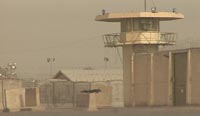
Tower at Abu Ghraib On Aug. 31, 2003, in response to a request for advice, Maj. Gen. Miller, the commander of Guantanamo, leads a team that visits and assesses prisoner facilities and operations in Iraq. Gen. Miller advises CJTF-7 to develop a guidance for interrogation policy and recommends consolidating Iraq's interrogation facilities at Abu Ghraib. "The importance of the rapid collection and dissemination of intelligence is vital for success and must be emphasized in the conduct of detention operations," Miller writes. "It is essential that the guard force be actively engaged in setting the conditions for successful exploitation of the internees." Sept. 14, 2003 Gen. Sanchez issues interrogation policy for Iraq
Based on Gen. Miller's recommendation, Lt. Gen. Ricardo Sanchez, the commander of U.S. forces in Iraq, issues a guidance for interrogation policy. Sanchez writes in his order that his policy is "modeled on the one implemented for interrogations conducted at Guantanamo Bay, but modified for applicability in a theater of war in which the Geneva Conventions apply." It notes that several techniques, including Incentive/Removal of Incentive, Environmental Manipulation, Pride and Ego Down (insulting the ego of a detainee), and Mutt and Jeff (a variation on good cop/bad cop), may be viewed as inhumane or inconsistent with the Geneva Conventions if applied to enemy prisoners of war, and requires the use of those techniques to be personally approved by Sanchez. The memo also allows the presence of military working dogs to exploit supposed Arab fears of dogs, as well as the use of stress positions. Learn more about the various interrogation techniques in this interactive feature from Slate. According to the Fay-Jones report, Sanchez approves the first instance of detainee isolation on Sept. 15, and the first instances of MI interrogators removing detainees' clothing appear on Sept. 16. Oct. 12, 2003 Sanchez revises policy
After concerns were expressed by CENTCOM lawyers, Sanchez issues a revised interrogation policy that supercedes his Sept. 14 memo. Although many of the same techniques appear in both memos, some of the guidance in the revised memo is more vague. For example, the tactic of using military dogs to exploit fears has been removed, but Sanchez writes, "Should military working dogs be present during interrogations, they will be muzzled and under the control of a handler at all times to ensure safety." The Taguba report would find "numerous incidents of sadistic, blatant, and wanton criminal abuses" at Abu Ghraib between October and December 2003. November 2003 Military dogs brought to Abu Ghraib
According to the Fay-Jones report, "Abusing detainees with dogs started almost immediately after the dogs arrived at Abu Ghraib." Jan. 13, 2004 Photos of Abu Ghraib abuse emerge
Spc. Joseph Darby turns over to investigators a CD with the infamous photos of abuse at Abu Ghraib. Gen. Antonio Taguba is assigned to investigate on Jan. 31 and issues a secret report on Feb. 25. The story becomes public in April 2004 via a report on 60 Minutes II and an article by Seymour Hersh in The New Yorker. March 2004 New interrogation guidance for Afghanistan
According to the Church report, a new interrogation guidance for CJTF-180 in Afghanistan, issued in March 2004, incorporates elements "identical" to those listed in Rumsfeld's April 16, 2003 memo approving techniques for use at Guantanamo. June 2004 Interrogation policy centralized
Gen. John Abizaid, commander of CENTCOM, directs all interrogations in CENTCOM territory, which consists of 25 Middle Eastern and Arab countries, to be standardized. According to the Church report, the new policy "relies almost exclusively on interrogation techniques specifically outlined in FM 34-52, and remains in effect today." Oct. 5, 2005 McCain torture amendment passes Senate
The amendment, sponsored by Sen. John McCain (R-Ariz.), would limit interrogation techniques to those in the Army Field Manual and prohibit "cruel, inhuman or degrading" treatment of detainees in U.S. custody. It passes the Senate by a vote of 90-9, despite opposition from the White House, which argues the bill would restrict the president's power to prosecute the war on terror and threatened a veto. home + introduction + watch online + is torture ever justified? + paper trail + analysis
posted oct. 18, 2005 FRONTLINE is a registered trademark of wgbh educational foundation. | SUPPORT PROVIDED BY
|

